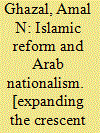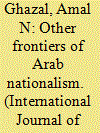| Srl | Item |
| 1 |
ID:
099023


|
|
|
|
|
| Publication |
London, Routledge, 2010.
|
| Description |
xiv, 171p.
|
| Series |
Culture and civilization in the Middle East
|
| Standard Number |
9780415779807, hbk
|
|
|
|
|
|
|
|
|
|
|
|
Copies: C:1/I:0,R:0,Q:0
Circulation
| Accession# | Call# | Current Location | Status | Policy | Location |
| 055272 | 320.5409174927/GHA 055272 | Main | On Shelf | General | |
|
|
|
|
| 2 |
ID:
094823


|
|
|
|
|
| Publication |
2010.
|
| Summary/Abstract |
The historiography of Arab nationalism has tended to concentrate on the secular press from the Mashriq, especially the Cairo-Beirut axis, at the expense of the religious nationalist press and the non-Mashriqi one. There is often an assumption that reliance on the secular press from the Mashriq alone can provide a clear picture of Arab intellectual life and that a proper analysis of that thought can be confined to a few intellectual centers in the eastern Arab world. Although there has never been an explicit claim that such a focus is the end of the story, there have not been enough attempts to look beyond the Cairo-Beirut axis and beyond its secular press organs in search of a broader story of the depth and breadth of Arab nationalism. This article addresses this imbalance by examining an Arabist-Salafi press network that operated between Algeria, Tunisia, Zanzibar, and Egypt and involved members of two sectarian communities, Sunnis and Ibadis. This Arabist-Salafi press network created a public sphere of intellectual engagement in which Salafism and nationalism were interwoven, producing a nationalist discourse transgressing post World War I borders of identity and linking the three layers of nationalism-the territorial, the Pan-Arab, and the Pan-Islamic-together. These layers not only intersected but also legitimized one another.
|
|
|
|
|
|
|
|
|
|
|
|
|
|
|
|